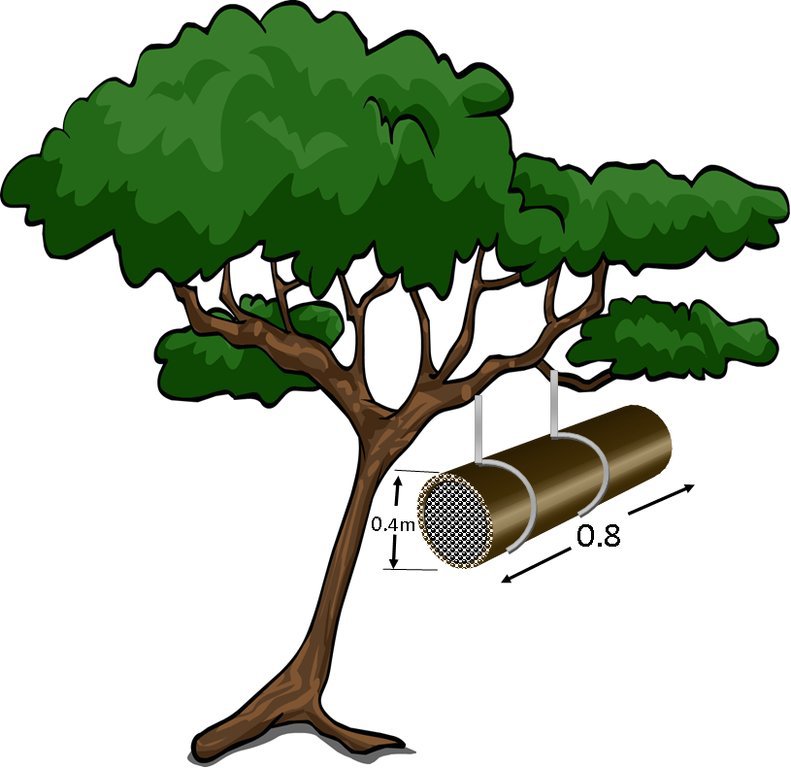



In northern Uganda, traditional bee hives used to be made from large tree trunks chiseled into a hollow cylindrical piece of tree trunk. Owing to increased demand for more hives and due to extensive destruction of suitable trees, farmers now use locally available bamboo stems for making bee hives. This technology, apart from being a response to decreasing availability of materials such as large tree trunks that were previously used to make bee hives, it is also meant to provide a cheaper alternative to expensive modern bee hives such as the top-bar and Langstroth.
Bamboo canes are peeled into sheets of approximately 2-3 meters, and weaved in a manner similar to the way the baskets are made but in a cylindrical shape. The hives are constructed with a length varying from 0.5-0.8 m, and 0.4 m in diameter. The resulting open-ended cylinder is then covered with a grass layer of about 2 cm thick and wrapped with polythene strings to keep the grass in place. The grass is meant to insulate the hive against heat. The open ends of the cylinder are closed using a wooded circular piece of wood punched with about 10 holes of 1 cm diameter. It is through these holes that bees enter the hive. The completed hives are hung into a tree, where the bees colonize and produce honey. The hive should face north or south to protect it from the direction of sun and rain. The sun heat melts the honey comb from which honey is extracted.
The apiary should be free from termites, birds, and hygiene should be fully maintained. The hives may also be hung on two poles attached by wires that are used to hang them. These poles should be greased to avoid being damaged by termites, bush fire and red ants. The apiary should be 30 m away from the main road, flowering plants and also near water source within 100 m is recommended.
An apiary with bamboo-woven been hives conserves the natural environment and honey extracted from the honey comb generates income to the farmer. Shades must be provided at the apiary site during dry seasons. To protect the apiary, scouting should be frequently done. Bees are harmful and the apiary occupies land from other activities like agriculture.
Farmers like this type of hive because it produces relatively clean honey compared to other systems. Furthermore, the bamboo hives last relatively longer because they are affected less by degrading insects. The low cost compared to other hives such as the top-bar or langstroth make it preferred by the bee farmers. However, there is also a high risk of fire since the hive is fitted with grass that could catch fire.

Lieu: Ayom Village, Abakadyak Parish, Northern, Ouganda
Nbr de sites de la Technologie analysés: site unique
Diffusion de la Technologie: appliquée en des points spécifiques ou concentrée sur une petite surface
Date de mise en oeuvre: 2009
Type d'introduction








| Spécifiez les intrants | Unité | Quantité | Coûts par unité (Uganda shilling) | Coût total par intrant (Uganda shilling) | % des coût supporté par les exploitants des terres |
| Main d'œuvre | |||||
| Harvesting bamboo canes | Manhours | 3,0 | 5000,0 | 15000,0 | 100,0 |
| Pealing the bamboo canes | Manhours | 5,0 | 5000,0 | 25000,0 | 100,0 |
| Weaving the been hives | Manhours | 15,0 | 5000,0 | 75000,0 | 100,0 |
| Equipements | |||||
| Bamboo canes | Pieces | 30,0 | 1500,0 | 45000,0 | 100,0 |
| Strings | Rolls | 1,0 | 6000,0 | 6000,0 | 100,0 |
| Baits | Piece | 1,0 | 10000,0 | 10000,0 | 100,0 |
| Coût total de mise en place de la Technologie | 176'000.0 | ||||
| Spécifiez les intrants | Unité | Quantité | Coûts par unité (Uganda shilling) | Coût total par intrant (Uganda shilling) | % des coût supporté par les exploitants des terres |
| Main d'œuvre | |||||
| Slashing | Area (acres) | 1,0 | 30000,0 | 30000,0 | 100,0 |
| Coût total d'entretien de la Technologie | 30'000.0 | ||||
Improve pollination of crop flowers leads to improved yields
Presence of bees in farm also deters other harmful insects that destroy crops or transmit crop pests and diseases
As a livestock, it results into more honey produced
Bees easily colonize hives made of locally available bambo or stake materials within their environment
This approach ensures integrated land management
Cost of buying a hive is not incurred
High yield of honey gives more income to the farmer
Both from crops, animals and honey.
Easy to manage the bees since there is little need to put baits
Farmers harvest adequate honey which is also rich in nutrients
Honey contain high nutrient content and also acts as antibiotics against some infections
Through marketing of the bee products in farmer groups
Farmers learn how to utilize locally available materials to make hives. e.g bamboo, ropes
In areas near national parks, bee keeping reduces human wildlife conflicts because bees repel away wild animals from reaching the farm stead
Pollination by bees improves plant diversity
Bees repel away some invasive insects from the environment
Increase in bees as social insects
The habitat become more diverse and plant species increase
Bees repel away some pests which infest crops or spread crop diseases
Increase in plant diversity because of the presence of bees create a bio-diverse micro climate